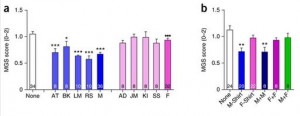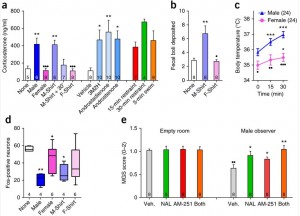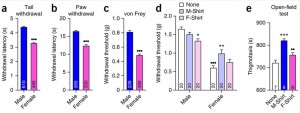Sex, Stress, and Pain in experimental design
The paper: Sorge, R.E. et al (2014) “Olfactory exposure to males, including men, causes stress and related analgesia in rodents.” Nature Methods. Published online 28 April 2014. doi:10.1038/Nmeth.2935
Subject areas: Animal behavior, Sex differences
Vocabulary:
analgesia – from Greek words meaning without pain. Analgesics are drugs that relieve pain, and mostly pain. This is different from anesthetics (or anesthesia) in which pain is also relieved, but other senses or even consciousness is also temporarily shut off.
—–
This article is a summary of a recent primary research paper intended for high school teachers to add to their general knowledge of current biology, or to supplement their lessons by showing students the kinds of projects that current biological research addresses.
—–
This paper appeared in a methods journal, which means that it was probably not expected to generate a lot of news and was mostly of practical interest to professional scientists who happen to use the experimental techniques discussed. However, as you will see, this could potentially (though not necessarily) have quite far-reaching effects.
The research here was actually a follow-up to a curious observation noted during previous research. That older research (2007), showed that behavioral indicators of pain in mice are diminished when there are people around. In fact, they showed that even a cardboard cutout of a person (just for fun, they used one of American celebrity heiress Paris Hilton) could help to lower the pain displayed by the mice. Following those observations, the research group wondered if it was only the sight of a person that has the analgesic effect, especially since rodents are known to rely heavily on their sense of smell. The idea was to see if the presence of certain odorants could affect the response to painful stimuli.
[A short aside here – pain research is terrifically important, as managing pain can obviously be a major part of medical treatments, but it can also be controversial because it may involve purposely inducing pain in the experimental animals. As a former member of an institutional animal care committee that had to approve any animal research going on at the university, I can say that pain experiments are given extra scrutiny to make sure that there is no other way to address the scientific question being investigated.]
In these experiments, pain was temporarily induced by injection of a sterile inflammatory drug into the ankle of the mouse. The pain experienced by the mouse was assessed by a number of behaviors, such as facial grimacing, withdrawal of the foot or leg, and wall-hugging.
When the initial rounds of experimentation were performed, the researchers found confusing results – in a number of the mice, there was little or no indication of pain from the injection. When they looked closely at the data, there seemed to be a correlation between the sex of the person doing the experiment and the level of pain displayed by the animal. Testing that correlation more thoroughly, the figure below shows the facial grimacing results from animals watched by male experimenters vs female experimenters in the observation room, as well as the results when the mice were recorded remotely without people in the room, but with t-shirts that had recently been worn by either male or female experimenters.
There are statistically significant decreases in pain display behavior for animals in the presence of a male or male scent. Furthermore, the pain decrease occurred regardless of the sex of the animal (though the effect on females was slightly stronger than the effect on male animals). The sex of the person who took care of the animals outside of the experiments did not have an effect, nor did the sex of the person who actually did the injection (if that was different from the person in the room right after the injection).
To try to address the basis of this pain attenuation, Sorge et al took a closer look at other behaviors exhibited by the mice in the presence of male or female t-shirts, male odorants, and other types of manipulation (figure below). In each test, the results support the idea that the analgesia is induced by stress. The figure below shows that stress hormone levels go up strongly in response to male odorants, similar to response to such stressful situations as being made to swim for 3 minutes or being restrained. Other physiological stress indicators that changed are body temperature, as well as fos gene expression in pain-processing neurons.
Finally, the researchers addressed the question of whether this pain attenuation only occurred after the specifically induced pain or if it happened even in the absence of a pain stimulus. So, they tested (again shown below)the baseline tendencies of mice that have either a male-worn or female-worn t-shirt in their room. Standard tests were run to see (a) how quickly the mice would withdraw their tail from hot water, or (b) withdraw their paw from a radiant heat source (not actually touching them with it). In (c) the hind paws of the mice were poked with little hair-like filaments called Von Frey filaments, and in (d) the amount of pressure applied by the filaments was varied for a more nuanced way to test sensitivity. Finally, (e) they tested to see if the mice were willing to run around the open space of their cage, or if they preferred to stay along the walls, indicating stress or fear. Again, there was a significant lowering of stress or pain thresholds in mice that were simply in the same room as a t-shirt previously worn by men without even having been subjected to an injection.
The implications of this are quite clear – although the numbers of women in biological research have been increasing in recent decades, the vast majority of animal studies were probably performed primarily by men, who could therefore have been unknowingly affecting the results. Many scientists try to support (or refute) their hypotheses through more than one method, so it is still quite likely that the overall interpretation of many old experiments are unchanged. However, in situations where there are only slight observable differences, or more limited papers addressing a question from only one experimental angle, it may be important to control for the sex of the experimenters, or at least any odorants given off by them.




No comments
Be the first one to leave a comment.